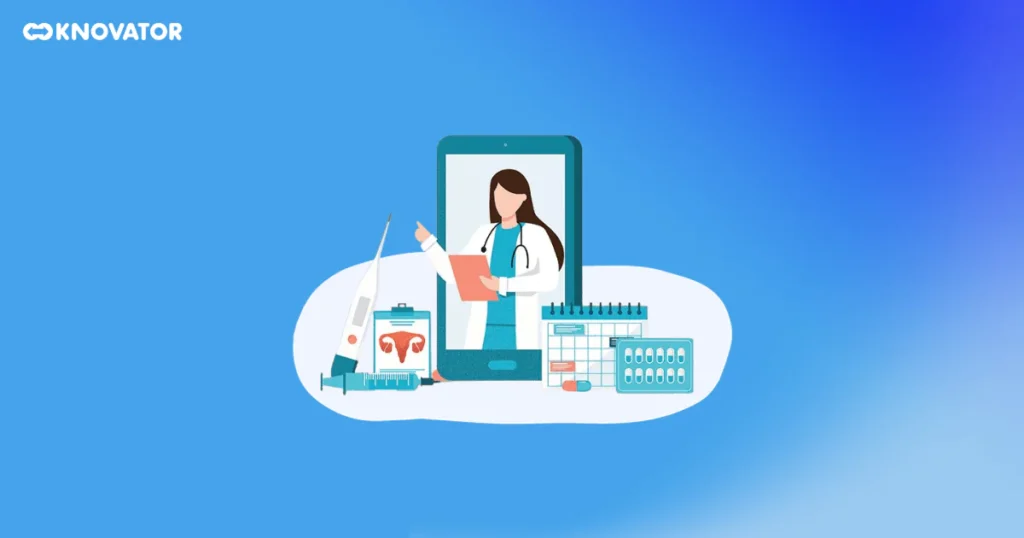Did you know 80% of women would consider getting gynecological treatment via telehealth?
Telehealth refers to the practice of providing healthcare remotely via telecommunication technologies. The application of telehealth to women’s healthcare services is known as gynecological telehealth.
In gynecology, telehealth has several advantages for both patients and healthcare providers. Telehealth can offer patients convenient, cheap, and easily accessible medical care. Moreover, it may lessen the time off and travel requirements. Telehealth can increase reach and boost productivity for healthcare providers.
Let’s explore the advantages, difficulties, uses, and prospects of telehealth in gynecology.
What Is Telehealth in Gynecology?
 In gynecology, telehealth uses telecommunication technologies to provide women’s healthcare remotely.
In gynecology, telehealth uses telecommunication technologies to provide women’s healthcare remotely.
This creative method reduces the distance between patients and healthcare professionals using encrypted messaging apps, phone calls, and video conferences.
By eliminating geographic obstacles and improving access to healthcare, women can receive gynecological consultations, follow-ups, and guidance from the comfort of their homes thanks to telehealth.
Real-time connection via secure messaging apps allows patients to discuss symptoms or concerns, while phone conversations provide prompt assistance and direction.
Video conferences allow medical practitioners to conduct virtual in-person consultations, assess patients, and administer individualized care visually. This approach guarantees convenience and encourages prompt treatments, which improve health outcomes.
Additionally, telehealth in gynecology empowers women by offering a private and secure setting for discussing delicate health matters and promoting a supportive healthcare environment.
Women’s healthcare is being revolutionized by telemedicine in gynecology, which is becoming more patient-centered, convenient, and efficient as technology advances.
Benefits Of Telehealth In Gynecology
 Let’s look at what telehealth in gynecology has to offer,
Let’s look at what telehealth in gynecology has to offer,
1. Convenience for patients and doctors
Telehealth in gynecology provides unmatched convenience for medical professionals and patients alike.
Patients can easily book appointments from the comfort of their homes, saving money and time on travel.
Similarly, healthcare providers can effectively manage consultations without being limited by physical space, allowing for more flexible scheduling and increased overall efficiency.
2. Reducing the need for physical visits
The potential of telehealth to lessen the need for in-person visits is one of its significant benefits in gynecology.
Medical professionals and patients can save time by remotely conducting routine check-ups, follow-ups, and exams.
This decrease in in-person visits also helps to minimize the burden on healthcare institutions and save healthcare costs.
3. Immediate consultations for urgent concerns
Instant consultations are made possible with telehealth, particularly in urgent gynecological concerns.
Through phone consultations or video conversations, patients may rapidly contact healthcare specialists and get their concerns addressed.
In emergencies, prompt involvement can be critical in ensuring patients receive the required information and assistance without delay.
4. Accessibility for remote or underserved populations
Remote or underprivileged people can receive crucial gynecological services because of telehealth, which eliminates geographic boundaries.
Women who live in remote or rural locations with few healthcare services can get professional consultations, recommendations, and follow-ups without traveling far.
This improved accessibility encourages parity in healthcare provision, guaranteeing that every woman, wherever she may be, will get the care she needs.
Challenges and Concerns
 Let’s see the issues with telehealth in gynecology,
Let’s see the issues with telehealth in gynecology,
1. Privacy and data security issues
Gynecological telehealth raises severe questions regarding patient privacy and data security. Patients who transmit sensitive medical data via digital platforms may be at risk of data breaches and unauthorized access.
Ensuring safe communication methods and protecting electronic health records are essential.
To safeguard patient confidentiality and confidence in telehealth services, health organizations must put strong encryption in place, adhere to data protection regulations, and conduct frequent security audits.
2. Misdiagnosis due to lack of physical examination
It can be challenging to provide telemedicine consultations without a physical examination, especially in gynecology, where such evaluations are frequently conducted.
Evaluations conducted in person may be necessary for circumstances that cannot be duplicated via video conversations. A mistaken diagnosis may result in severe repercussions if a physical examination is not performed.
Healthcare professionals need to find a balance between encouraging follow-ups to confirm diagnoses given remotely, making sure patients are referred to in-person care when appropriate, and carefully evaluating the limitations of telehealth.
3. Technological barriers for older patients or those without access
Technological hurdles reduce the effectiveness of telehealth, particularly for older patients or those who need access to digital gadgets and the Internet.
Specific populations may be unable to use telehealth services due to low internet connectivity, a lack of cell phones, or limited digital literacy.
To provide fair access to telehealth services, bridging this digital divide would require targeted activities like investments in internet infrastructure improvement in underprivileged areas and technological training programs for older persons.
4. Licensing and regulatory challenges
The fact that telehealth services frequently cross national borders complicates licensing and legal requirements.
It might be challenging to understand the licensing requirements for healthcare providers in the state or nation where the patient resides, particularly in an emergency.
The provision of uniform and standardized telehealth services is further complicated by regionally disparate rules of telehealth practices, insurance coverage, and reimbursement guidelines.
To overcome these obstacles, international cooperation and faster cross-border licensing processes are needed to create uniform rules that support the smooth delivery of telehealth services while guaranteeing patient safety and high-quality treatment.
Applications of Telehealth in Gynecology
 Time to take a look at applications of telehealth in gynecology,
Time to take a look at applications of telehealth in gynecology,
1. Routine check-ups and consultations
Regular check-ups and consultations are made easier with telehealth in gynecology.
Women can use encrypted messaging applications or video conversations to discuss primary gynecological concerns, menstruation issues, and contraception alternatives with healthcare specialists.
Regular check-ups can be performed remotely and don’t always require a physical inspection.
Women’s general health and well-being are enhanced by this convenience, which promotes routine healthcare encounters, early detection of possible problems, and preventive care.
2. Prescription renewals
Prescription renewals are made more accessible via telehealth, particularly for common drugs like hormone therapy and contraception.
Patients can renew prescriptions by corresponding with their gynecologists via safe digital platforms.
To ensure the safe continuation of drugs, healthcare providers might assess the patient’s medical history and current status.
By guaranteeing ongoing access to necessary medications without requiring in-person visits, this streamlined method improves medication adherence and management while saving time for both patients and physicians.
3. Post-operative care and follow-ups
Post-operative care and follow-ups are essential for tracking recovery and resolving issues following gynecological operations.
Using telehealth, medical professionals can perform virtual post-operative evaluations to monitor for problems and make sure the patient is healing properly.
Through video consultations, patients can talk about their recovery, ask concerns, and get advice on post-surgery care.
This continuity of care improves patient outcomes following gynecological surgeries by reducing the need for frequent trips, increasing patient comfort, and enabling rapid interventions.
4. Counseling and education
Gynecological telehealth offers a valuable platform for counseling and teaching.
Through virtual counseling sessions, women can discuss reproductive health issues, get advice on family planning alternatives, and receive mental health assistance.
Healthcare professionals can also conduct teaching sessions on subjects like menopause, pregnancy, and sexual health, thanks to telehealth.
These workshops give women the knowledge they need to make educated decisions regarding their general and reproductive health.
Because telehealth is interactive, it may provide customized counseling and education, creating a safe space where women feel comfortable sharing their worries and getting professional advice.
Future of Telehealth in Gynecology
 Gynecological telehealth is going to undergo revolutionary changes in the future. Artificial intelligence and virtual reality are two emerging technologies that will likely improve diagnostic capabilities.
Gynecological telehealth is going to undergo revolutionary changes in the future. Artificial intelligence and virtual reality are two emerging technologies that will likely improve diagnostic capabilities.
AI-powered algorithms can analyze medical data, helping to make more accurate diagnoses, while VR can create immersive environments for virtual examinations.
Wearable devices and remote monitoring tools will continuously track vital signs and specific health metrics, giving healthcare providers real-time data.
These innovations promise more comprehensive, data-driven, and personalized care, revolutionizing how gynecological services are provided remotely.
Let’s explore the future of telehealth in gynecology further.
Policy changes and their implications
Promoting telehealth-friendly laws can encourage broad implementation into traditional healthcare systems.
Policies about data protection, licensing across national and international borders, and reimbursement will also need to change in response to the changing telehealth environment.
A good amount of regulations will incentivize medical professionals to allocate resources toward telehealth innovations, guaranteeing enduring, superior, and easily obtainable gynecological care for women all over the globe.
In addition, for legislative improvements to effectively address healthcare disparities, fair access must be prioritized, particularly for underprivileged areas.
Expanding the scope of services offered
Women can determine their risk for inherited gynecological problems by integrating genetic counseling and testing services into telehealth platforms, encouraging proactive healthcare planning.
Recognizing the significance of overall well-being, mental health support, including therapy and counseling, will be effortlessly incorporated.
In addition, telehealth platforms will integrate other interactive elements that promote community involvement, peer assistance, and educational forums, thus establishing a holistic ecosystem for women’s health.
This service expansion will make gynecological care more inclusive by redefining the requirements.
Telehealth In Gynecology For A Better Tomorrow
Gynecological telehealth is transforming women’s healthcare by providing unmatched accessibility and convenience.
Ongoing technical developments and policy changes are overcoming obstacles like misdiagnosis risks and privacy concerns.
Gynecological telemedicine has a bright future thanks to the integration of AI and VR. People must understand the advantages and disadvantages of this treatment and talk about it with their doctors. While telehealth isn’t suitable for everyone, it can offer many women high-quality care.
FAQs
Q1. In gynecology, what is telehealth, and how does it operate?
A1. In gynecology, telehealth refers to using technology to provide healthcare services remotely. Through video conversations or messaging apps, patients can speak virtually with gynecologists about symptoms, prescriptions, or general issues without visiting the clinic physically.
Q2. Is telehealth for gynecological exams as efficient as in-person visits?
A2. Telehealth works well for many consultations, including discussing symptoms, renewing prescriptions, and scheduling follow-ups. However, in-person visits may be required for some physical examinations. While telehealth consultations are convenient, the doctor will still assess each patient’s unique medical needs to determine the best action.
Q3. How safe is telehealth for gynecology, and how secure are health records?
A3. Platforms for telehealth provide patients’ privacy and data protection priority. To protect medical information, reputable telehealth providers use encrypted connections and follow tight privacy laws.







